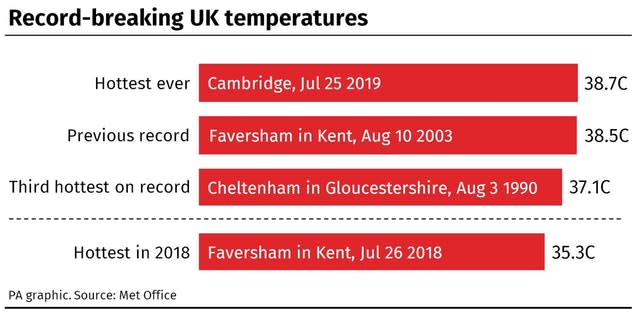July 2019 was warmest on record – but only fractionally, data shows
July was the warmest month on record worldwide, but only by a fraction, new figures show.
Data published by the European Union’s Copernicus Climate Change Service (C3S) reveals that July 2019 was around 0.56C warmer than the 1981-2010 global average.
This is close to 1.2C above pre-industrial levels and about 0.04C warmer than July 2016 – the previous warmest July globally.
But C3S said the difference in temperatures for July 2016 and 2019 is “very small”.
Head of C3S Jean-Noel Thepaut said: “While July is usually the warmest month of the year for the globe, according to our data it also was the warmest month recorded globally by a very small margin.
“With continued greenhouse gas emissions and the resulting impact on global temperatures, records will continue to be broken in the future.”
#Copernicus Climate Change Service (#C3S) @CopernicusECMWF confirms July 2019 temperatures marginally higher than July 2016, & therefore most likely becomes the hottest month on record #climatecrisis #climateemergency Read more below: https://t.co/aEz8BcZkWC
— Copernicus EU (@CopernicusEU) August 5, 2019
But, July is not alone in being hot.
The C3S data also shows that all months of 2019 so far rank among the four warmest for the month in question, and that June this year was also the warmest on record.
Western Europe was also warmer than average, largely due to a heatwave in the last week of the month, with eastern Europe cooler than usual.
Temperatures over Alaska, Greenland, parts of Siberia, swathes of Antarctica, the central Asian republics and Iran, were also “particularly high compared to the 1981-2010 average”, C3S said.
Meanwhile, Africa and Australia were above average over almost all of each continent.

In Britain, July saw the highest temperature ever recorded in the UK – with the mercury reaching 38.7C (101.7F) in Cambridge University Botanic Garden on July 25.
Despite the heat, figures published by the Met Office on Friday showed that the county of Cheshire received more than twice the average rainfall for the month – 219%.
Other counties in central and northern England, including Lancashire, Staffordshire, Derbyshire and Leicestershire, also received more than one-and-a-half times the month’s typical rainfall for July.
But the Met Office said some parts of western Britain have been much drier than average so far this summer.
Pembrokeshire has only received about one third (31%) of July’s usual average rainfall, and during the first two months of summer it has seen just over one half or 53% of the summer’s average rainfall.

 Yahoo News
Yahoo News 
